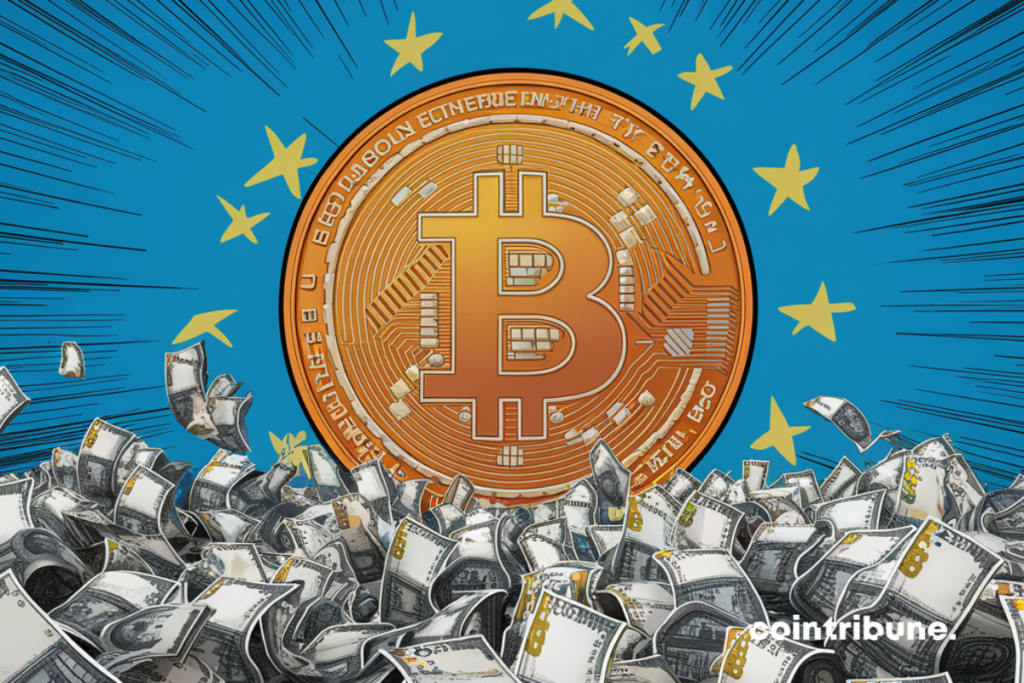BREAKING! The #ECB lowers interest rates for the first time since 2019. pic.twitter.com/42chrvXnL5
— jeroen blokland (@jsblokland) June 6, 2024
A
A
Bitcoin - European Central Bank (ECB) Reopens the Floodgates
Fri 07 Jun 2024 ▪
4
min read ▪ by
Getting informed
▪
Invest
After the Canadian central bank, it is now the turn of the European Central Bank to start lowering rates. Good news for bitcoin.

The ECB begins its rate cuts
While the FED struggles with persistent inflation, its European counterpart has decided to loosen its grip for the first time in five years. The key interest rate falls from 4.50% to 4.25%.
This monetary easing comes despite an incidental rise in the annual inflation rate. We went from 2.2% to 2.4% last month. The ECB has even raised its inflation forecasts for the coming year…
Facing this contrast, Christine Lagarde conceded that the road might be bumpy in the coming months. In other words, inflation could be unpredictable.
The president mainly highlighted geopolitical risks that could impact energy prices and international trade. Notably, the economic war between the West and the Sino-Russian bloc.
Ms. Lagarde therefore specified that the ECB “does not commit” to a predetermined pace. Indeed, the graph shows that central banks rarely stop in the middle of their course. Rate cuts should therefore continue on a monthly or bi-monthly basis if inflation stays in line with expectations.
The question now is how far will the rates go down? The latest statements from the ECB’s leaders suggest that we will not return below 2%. Time will tell…
Meanwhile, the ECB confirms that the €1,850 billion of debt bought during the pandemic will be sold off gradually starting in July. At a rate of 7.5 billion per month to be precise. At this rate, it will take 20 years to clear this portion of the ECB’s balance sheet…
Good news for bitcoin
This relatively quick rate reduction was anticipated. Indeed, if we take a step back, the fiat system is a Ponzi scheme. In short, it is necessary for the flow of new loans to continuously exceed the flow of repayments. Otherwise, the system collapses.
This requirement stems from the fact that all the money in circulation comes from debt (except for coins and banknotes). We are therefore constantly paying interest on the entire money supply. This must grow so that everyone can find enough money in the economy to repay their loan AND the interest.
Raising rates aims to ensure new loans no longer exceed repayments. The amount of money in circulation decreases, prompting a reduction in consumption and hence, inflation.
The annual growth of the money supply (M3) was close to 0% recently. But a central bank cannot afford to keep rates high for too long. The money supply growth must return to its cruising speed (~4% per year) to avoid economic damage.
And unless there is sufficient energy to match this exponentially increasing money supply, we will have inflation. An inflation more or less disguised by the accounting tricks of statistical institutes…
There is concern about Europe’s energy supply, which is now paying three times more for its gas than before… On this topic, don’t miss this article: Bitcoin and Endless Inflation.
All this to say that you should not leave your savings in fiat money. It is wiser to keep it in a currency that exists in a finite amount: bitcoin.
“`
Maximize your Cointribune experience with our "Read to Earn" program! For every article you read, earn points and access exclusive rewards. Sign up now and start earning benefits.
A
A
Bitcoin, geopolitical, economic and energy journalist.
DISCLAIMER
The views, thoughts, and opinions expressed in this article belong solely to the author, and should not be taken as investment advice. Do your own research before taking any investment decisions.